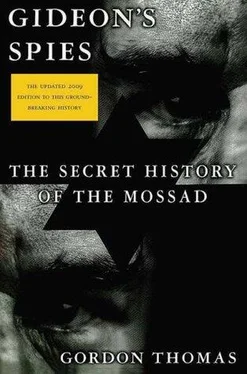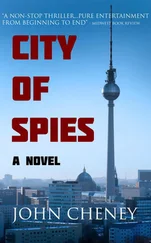Gordon Thomas - Gideon's Spies
Здесь есть возможность читать онлайн «Gordon Thomas - Gideon's Spies» весь текст электронной книги совершенно бесплатно (целиком полную версию без сокращений). В некоторых случаях можно слушать аудио, скачать через торрент в формате fb2 и присутствует краткое содержание. Город: New York, Год выпуска: 2009, ISBN: 2009, Издательство: Thomas Dunne Books, Жанр: История, на английском языке. Описание произведения, (предисловие) а так же отзывы посетителей доступны на портале библиотеки ЛибКат.
- Название:Gideon's Spies
- Автор:
- Издательство:Thomas Dunne Books
- Жанр:
- Год:2009
- Город:New York
- ISBN:978-0-312-53901-6
- Рейтинг книги:4 / 5. Голосов: 1
-
Избранное:Добавить в избранное
- Отзывы:
-
Ваша оценка:
- 80
- 1
- 2
- 3
- 4
- 5
Gideon's Spies: краткое содержание, описание и аннотация
Предлагаем к чтению аннотацию, описание, краткое содержание или предисловие (зависит от того, что написал сам автор книги «Gideon's Spies»). Если вы не нашли необходимую информацию о книге — напишите в комментариях, мы постараемся отыскать её.
Gideon’s Spies
Gideon's Spies — читать онлайн бесплатно полную книгу (весь текст) целиком
Ниже представлен текст книги, разбитый по страницам. Система сохранения места последней прочитанной страницы, позволяет с удобством читать онлайн бесплатно книгу «Gideon's Spies», без необходимости каждый раз заново искать на чём Вы остановились. Поставьте закладку, и сможете в любой момент перейти на страницу, на которой закончили чтение.
Интервал:
Закладка:
Almost daily, Israeli soldiers and civilians were shot dead in the streets of Jerusalem, Tel Aviv, and Haifa. Desperate to regain authority, Defense Minister Yitzhak Rabin announced he was implementing a policy of “force, might and beatings,” but it had little effect.
Beset by deepening interservice strife, the Israeli intelligence community was unable to agree on a coordinated policy to deal with mass Arab resistance on a scale not seen since the War of Independence. An added thorn was the criticism from the United States over the growing evidence on TV screens of the brutal methods deployed by Israeli soldiers. For the first time U.S. networks, normally friendly to Israel, began to screen footage which, for sheer brutality, matched what had happened in Beijing’s Tiananmen Square. Two Israeli soldiers were filmed relentlessly smashing a rock against the arm of a Palestinian youth; an IDF patrol was caught on camera beating a pregnant Palestinian mother; children in Hebron were shown having IDF rifle butts smashed against their bodies for throwing stones.
The Intifada coalesced to form the United National Leadership of the Uprising. Every Arab community was postered with instructions in Arabic on how to stage strikes, close shops, boycott Israeli goods, refuse to recognize the civil administration. It was reminiscent of the resistance in the last days of the German occupation of France in World War II.
Desperate to reestablish Mossad’s preeminent role among the intelligence community, Nahum Admoni took action. On February 14, 1988, a kidon team was sent to the Cypriot port of Limassol. They planted a powerful bomb on the chassis of a Volkswagen Golf. It belonged to one of the leaders of the Intifada, Muhammad Tamimi. With him were two senior PLO officers. They had met with Libyan officials who had handed over $1 million to continue bankrolling the Intifada. All three men were killed in the massive explosion that rocked the entire port.
The following day, Mossad struck again—planting a limpet mine on the hull of the Soi Phayne, a passenger ship the PLO had just bought for an intended public relations exercise. With the world’s press on board, the ship would have sailed to Haifa as a poignant reminder of the Palestinians’ “right to return” to their homeland—and a more pointed reminder of the Jewish boats, immortalized by the Exodus, which, forty years before, had defied the British navy to bring the survivors of the Holocaust to Israel, also under their “right to return.” The Soi Phayne was destroyed.
The operations had done nothing to daunt Arab determination. At every turn guerrillas were able to outsmart the Israelis, whose only response seemed to be violence and more violence. The world watched as Israel not only failed to stop the Intifada but also lost the propaganda war. Commentators made the comparison that here was a modern-day David-versus-Goliath conflict, with the IDF cast in the role of the Philistine giant.
Yasser Arafat used the Intifada as an opportunity to regain control over his dispossessed people. Around the world his voice cracked with fury on radio and television that what was happening was the direct result of Israel’s policy of stealing Arab land. He urged every Arab to rally in support. One day Arafat was in Kuwait urging Hamas, the terrorist group backed by Iran, to provide its deadly skills. The next he was in Lebanon, meeting with the leaders of Islamic Jihad. Arafat was achieving what had, only a short time before, seemed impossible—uniting Arabs of all persuasions in a common cause. To them all he was “Mr. Palestine” or “Chairman.”
Mossad was constantly flummoxed by Arafat’s strategies as he flitted between Arab capitals. It had little or no warning where he would turn up, or whom he would next rally to his side.
All this and more Rafi Eitan explained to his houseguest, Earl Brian. In turn Brian described how Promis worked. In his view, there was still work to be done to bring the program up to speed. Rafi Eitan realized that Promis could then have an impact on the Intifada. For a start, the system could lock on to computers in the PLO’s seventeen offices scattered around the world to see where Arafat was going and what he could be planning. Rafi Eitan put aside his foraging for scrap metal and focused on how to exploit the brave new world Promis offered.
No longer, for instance, would it be necessary to rely solely on human intelligence to understand the mind-set of a terrorist. With Promis it would be possible to know exactly when and where he would strike. Promis could track a terrorist’s every step.
To achieve such a breakthrough would once more undoubtedly make him a powerful figure in the Israeli intelligence community. But the wounds inflicted on him by his former peers had gone deep. He had been turned out into the cold with little more than a modest pension. He was getting on in years; his first obligation was to his family, whom, through his work, he had been forced to neglect for long periods. Promis offered an opportunity to make amends; handled properly, it could make his fortune. However, for all his brilliance, Rafi Eitan was no computer genius; his skills in that area extended to little more than switching on his modem. But his years at LAKAM had given him access to all the experts he would need.
When Earl Brian returned to the United States, Rafi Eitan put together a small team of former LAKAM programmers. They deconstructed the Promis disc and rearranged its various components, then added several elements of their own. There was no way for anyone to be able to claim ownership of what Promis had become. Rafi Eitan decided to keep the original name because it was “a good marketing tool to explain what the system was.”
Intelligence operatives, untrained in computer technology beyond knowing which keys to tap, would be able to access information and judgments far more comprehensive than they could ever carry in their own heads. A Promis disc could fit a laptop computer and choose from a myriad of alternatives the one that made most sense. It would eliminate the need for deductive reasoning because there were too many correct but irrelevant matters to simultaneously take into account for human reasoning alone to suffice. Promis could be programmed to eliminate all superfluous lines of inquiry and amass and correlate data at a speed and scale beyond human capability.
But before it could be sold, according to Ben-Menashe, Rafi Eitan needed to add one further element. Ben-Menashe later claimed he was asked to organize the insertion of a “trapdoor,” a built-in chip that, unknown to any purchaser, would allow Rafi Eitan to know what information was being sought.
Ben-Menashe knew someone who could create a trapdoor that even the most sophisticated scanners would be unable to detect. The man ran a small computer research and development company in Northern California. He and Ben-Menashe had been schoolboy friends, and for five thousand dollars he agreed to produce the microchip. It was, Ben-Menashe admitted, cheap at the price. The next stage would be to test the system.
Jordan was selected as the site, not only because it bordered on Israel, but because it had become a haven for the leaders of the Intifada. From the desert kingdom, they directed the Arab street mobs on the West Bank and Gaza to launch further attacks inside Israel. After an atrocity, PLO terrorists would slip across the border into Jordan, doing so often with the connivance of the Jordanian army.
Consequently, long before the Intifada, Jordan had become a proving ground for Mossad to develop its electronic skills. In the 1970s, Mossad technicians had tapped into the computer IBM had sold to the country’s military intelligence service. The information gained had supplemented that provided by the deep-cover katsa Rafi Eitan had placed inside King Hussein’s palace. Promis would offer much more.
Читать дальшеИнтервал:
Закладка:
Похожие книги на «Gideon's Spies»
Представляем Вашему вниманию похожие книги на «Gideon's Spies» списком для выбора. Мы отобрали схожую по названию и смыслу литературу в надежде предоставить читателям больше вариантов отыскать новые, интересные, ещё непрочитанные произведения.
Обсуждение, отзывы о книге «Gideon's Spies» и просто собственные мнения читателей. Оставьте ваши комментарии, напишите, что Вы думаете о произведении, его смысле или главных героях. Укажите что конкретно понравилось, а что нет, и почему Вы так считаете.












